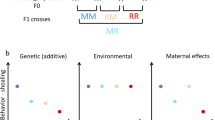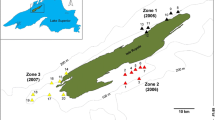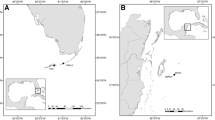Abstract
Morphological and behavioral traits affect an individual’s fitness and can reflect both evolutionary adaptations and phenotypic responses to environmental conditions. We conducted a reciprocal transplant ‘common garden’ experiment at two temperature regimes to test for phenotypic plasticity in morphological and behavioral traits between and within two populations of steelhead Oncorhynchus mykiss from Hood Canal, WA, USA. The Dewatto River and Duckabush River populations exhibited asymmetric changes in body morphology in response to the two temperature regimes, suggesting both between- and within-population variation in morphological plasticity. In most cases, within population variation in body shapes was less than between temperature regimes. Most notably the populations differed in dorso-ventral and caudal regions, body depth, and head shape, with some differences on the anterior-posterior placement of the dorsal and ventral fins. The warm temperature regime caused more exploratory behavior, more charging behavior, and higher fin erosion, and population effects included slight differences in feeding aggression frequency. Morphology appeared to vary more between populations than between temperature regimes, and behavioral traits varied more between temperature regimes than between populations. Morphological variation may reflect adaptations to variation in freshwater habitat conditions, and both populations show behavioral plasticity in response to temperature. This study sheds new light on the role of genetic and environmental influence on morphology and behavior in juvenile steelhead.







Similar content being viewed by others
References
Abbott JC, Dill LM (1985) Patterns of aggressive attack in juvenile steelhead trout (Salmo gairdneri). Can J Fish Aquat Sci 42(11):1702–1706
Akaike H (1974) A new look at statistical-model identification. IEEE Trans Autom Control AC19(6):716–723. doi:10.1109/tac.1974.1100705
Arendt JD, Wilson DS (1997) Optimistic growth: competition and an ontogenetic niche-shift select for rapid growth in pumpkinseed sunfish (lepomis gibbosus). Evolution 51(6):1946–1954. doi:10.2307/2411015
Bates D, Maechler M, Bolker B and Walker S (2014) _lme4: Linear mixed-effects models using Eigen and S4_. R package version 1.1-7, <URL: http://CRAN.R-project.org/package=lme4>
Beeman JW, Rondorf DW, Tilson ME, Venditti DA (1995) A nonlethal measure of smelt status of juvenile steelhead based on body morphology. T Am Fish Soc 124(5):764–769. doi:10.1577/1548-8659(1995)124<0764:anmoss>2.3.co;2
Berejikian BA, Tezak EP (2005) Rearing in enriched hatchery tanks improves dorsal fin quality of juvenile steelhead. N Am J Aquac 67(4):289–293. doi:10.1577/a05-002.1
Berejikian BA, Mathews SB, Quinn TP (1996) Effects of hatchery and wild ancestry and rearing environments on the development of agonistic behavior in steelhead trout (Oncorhynchus mykiss) fry. Can J Fish Aquat Sci 53(9):2004–2014. doi:10.1139/cjfas-53-9-2004
Berejikian BA, Tezak EP, Schroder SL, Knudsen CM, Hard JJ (1997) Reproductive behavioral interactions between wild and captively reared coho salmon (Oncorhynchus kisutch). ICES J Mar Sci 54(6):1040–1050. doi:10.1006/jmsc.1997.0293
Berejikian BA, Campbell LA, Moore ME (2013) Large-scale freshwater habitat features influence the degree of anadromy in eight Hood Canal Oncorhynchus mykiss populations. Can J Fish Aquat Sci 70(5):756–765. doi:10.1139/cjfas-2012-0491
Bookstein FL (1991) Morphometric tools for landmark data. Cambridge University Press, New York
Boughton DA, Gibson M, Yedor R, Kelley E (2007) Stream temperature and the potential growth and survival of juvenile Oncorhynchus mykiss in a southern California Creek. Freshw Biol 52(7):1353–1364. doi:10.1111/j.1365-2427.2007.01772.x
Bourke P, Magnan P, Rodriguez MA (1997) Individual variations in habitat use and morphology in brook charr. J Fish Biol 51(4):783–794. doi:10.1006/jfbi.1997.0481
Brunelli JP, Wertzler KJ, Sundin K, Thorgaard GH (2008) Y-specific sequences and polymorphisms in rainbow trout and Chinook salmon. Genome 51(9):739–748
Burnham KP, Anderson DR (1998) Model selection and multimodel inference: a practical information-theoretic approach. Springer, New York
Campbell MR, Kozfkay CC, Copeland T, Schrader WC, Ackerman MW, Narum SR (2012) Estimating abundance and life history characteristics of threatened wild Snake River steelhead stocks by using genetic stock identification. T Am Fish Soc 141:1310–1327
Carl LM, Healey MC (1984) Differences in enzyme frequency and body morphology among 3 juvenile life-history types of Chinook (Oncorhynchus tshawyacha) in the Nanaimo River, British Columbia. Can J Fish Aquat Sci 41(7):1070–1077. doi:10.1139/f84-125
Chapman DW (1962) Aggressive behavior in juvenile coho salmon as a cause of emigration. J Fish Res Board Can 19(6):1047–1080
Chapman DW (1966) Food and space as regulators of salmonid populations in streams. Am Nat 100:345–358
Doctor KK, Berejikian BA, Hard JJ, Van Doornik D (2014) Growth-mediated life history traits of steelhead reveal phenotypic divergence and plastic response to temperature. T Am Fish Soc 143(2):317–333. doi:10.1080/00028487.2013.849617
Drinan TJ, McGinnity P, Coughlan JP, Cross TF, Harrison SS (2012) Morphological variability of Atlantic salmon Salmo salar and brown trout Salmo trutta in different river environments. Ecol Freshw Fish 21(3):420–432. doi:10.1111/j.1600-0633.2012.00561.x
Dynes J, Magnan P, Bernatchez L, Rodriguez MA (1999) Genetic and morphological variation between two forms of lacustrine brook charr. J Fish Biol 54(5):955–972. doi:10.1006/jfbi.1998.0920
Ebersole JL, Liss WJ, Frissell CA (2001) Relationship between stream temperature, thermal refugia and rainbow trout Oncorhynchus mykiss abundance in arid-land streams in the northwestern United States. Ecol Freshw Fish 10(1):1–10. doi:10.1034/j.1600-0633.2001.100101.x
Einum S, Fleming D (2001) Implications of stocking: ecological interactions between wild and released salmonids. Nord J Freshw Res 75:56–70
Elliott JM (1994) Quantitative ecology and the brown trout. Oxford University Press, Oxford
Fleming IA, Gross MR (1989) Evolution of adult female life-history and morphology in a Pacific Salmon (coho, Oncorhynchus kisutch). Evolution 43(1):141–157. doi:10.2307/2409170
Grant JWA (1990) Aggressiveness and the foraging behavior of young-of-the-year brook charr (Salvelinus fontinalis). Can J Fish Aquat Sci 47(5):915–920. doi:10.1139/f90-105
Grant JWA, Noakes DLG (1988) Aggressiveness and foraging mode of young-of-the-year brook charr (Salvelinus fontinalis). Behav Ecol Sociobiol 22(6):435–445. doi:10.1007/bf00294982
Grünbaum T, Cloutier R, Mabee PM, Le Francois NR (2007) Early developmental plasticity and integrative responses in arctic charr (Salvelinus alpinus): Effects of water velocity on body size and shape. J Exp Zool Part B 308B(4):396–408. doi:10.1002/jez.b.21163
Hard JJ, Berejikian BA, Tezak EP, Schroder SL, Knudsen CM, Parker LT (2000) Evidence for morphometric differentiation of wild and captively reared adult coho salmon: a geometric analysis. Environ Biol Fish 58(1):61–73. doi:10.1023/a:1007646332666
Hard JJ, Myers JM, Ford MJ et al (2007) Status review of Puget Sound steelhead (Oncorhynchus mykiss). United States Department of Commerce, NOAA Technical Memorandum, NMFS-NWFSC-81
Hartman GF (1965) Significance of early emergence, environmental rearing capacity, and behavioral ecology of juvenile coho salmon in stream channels. J Fish Res Board Can 22:173–189
Hawkins DK, Quinn TP (1996) Critical swimming velocity and associated morphology of juvenile coastal cutthroat trout (Oncorhynchus clarki clarki), steelhead trout (Oncorhynchus mykiss), and their hybrids. Can J Fish Aquat Sci 53(7):1487–1496. doi:10.1139/cjfas-53-7-1487
Hoar WS (1951) The behavior of chum, pink and coho salmon in relation to their seeward migration. J Fish Res Board Can 8:241–243
Hoar WS (1958) The evolution of migratory behaviour among juvenile salmon of the genus Oncorhynchus. J Fish Res Board Can 15:391–428
Hokanson KEF, Kleiner CF, Thorslund TW (1977) Effects of constant temperatures and diel temperature-fluctuations on specific growth and mortality-rates and yield of juvenile rainbow trout (Salmo gairdneri). J Fish Res Board Can 34(5):639–648
Hoogenboom MO, Armstrong JD, Groothuis TGG, Metcalfe NB (2013) The growth benefits of aggressive behavior vary with individual metabolism and resource predictability. Behav Ecol 24(1):253–261
Huntingford FA (2004) Implications of domestication and rearing conditions for the behaviour of cultivated fishes. J Fish Biol 65:122–142. doi:10.1111/j.1095-8649.2004.00562.x
Jones OR, Wang JL (2010) Colony: a program for parentage and sibship inference from multilocus genotype data. Mol Ecol Resour 10(3):551–555
Keeley ER, Grant JWA (1995) Allometric and environmental correlates of territory size in juvenile Atlantic salmon (Salmo salar). Can J Fish Aquat Sci 52(1):186–196. doi:10.1139/f95-019
Kindschi GA (1987) Method for quantifying degree of fin erosion. Prog Fish Cult 49(4):314–315
Kovac V (2002) Synchrony and heterochrony in ontogeny (of fish). J Theor Biol 217(4):499–507. doi:10.1006/yjtbi.3043
Latremouille DN (2003) Fin erosion in aquaculture and natural environments. Rev Fish Sci 11(4):315–335. doi:10.1080/10641260390255745
Lawrence MA (2013). ez: Easy analysis and visualization of factorial experiments. R package version 4.2-2. http://CRAN.R-project.org/package=ez
Lima SL, Dill LM (1990) Behavioral decisions made under the risk of predation- a review and prospectus. Can J Zool 68(4):619–640. doi:10.1139/z90-092
Lohmus M, Sundstrom LF, Bjorklund M, Devlin RH (2010) Genotype-Temperature Interaction in the Regulation of Development, Growth, and Morphometrics in Wild-Type, and Growth-Hormone Transgenic Coho Salmon. Plos One 5 (3). doi:10.1371/journal.pone.0009980
Lott DF (1984) Intraspecific variation in the social systems of wild vertebrates. Behaviour 88:266–325. doi:10.1163/156853984x00353
McCarthy SG, Duda JJ, Emlen JM, Hodgson GR, Beauchamp DA (2009) Linking habitat quality with trophic performance of steelhead along forest gradients in the south fork Trinity River watershed, California. T Am Fish Soc 138(3):506–521. doi:10.1577/t08-053.1
Mizzau TW, Garner SR, Marklevitz SAC, Thompson GJ, Morbey YE (2013) A genetic test of sexual size dimorphism in pre-emergent Chinook salmon. PLoS ONE 8(10):e78421. doi:10.1371/journal.pone.0078421
Myrick CA, Cech JJ (2000) Temperature influences on California rainbow trout physiological performance. Fish Physiol Biochem 22(3):245–254
Nielsen JL (1992) Microhabitat-specific foraging behavior, diet, and growth of juvenile coho salmon. T Am Fish Soc 121(5):617–634
Nielsen JL, Lisle TE, Ozaki V (1994) Thermally stratified pools and their use by steelhead in Northern California streams. T Am Fish Soc 123(4):613–626. doi:10.1577/1548-8659(1994)123<0613:tspatu>2.3.co;2
Nunn AD, Tewson LH, Cowx IG (2012) The foraging ecology of larval and juvenile fishes. Rev Fish Biol Fish 22(2):377–408
Parsons KJ, Robinson BW, Hrbek T (2003) Getting into shape: an empirical comparison of traditional truss-based morphometric methods with a newer geometric method applied to New World cichlids. Environ Biol Fish 67(4):417–431. doi:10.1023/a:1025895317253
Pigliucci M (1998) Developmental phenotypic plasticity: where internal programming meets the external environment. Curr Opin Plant Biol 1(1):87–91. doi:10.1016/s1369-5266(98)80133-7
Puckett KJ, Dill LM (1985) The energetics of feeding territoriality in juvenile coho salmon (Oncorhynchus kisutch). Behaviour 92:97–111
Puget Sound Steelhead Technical Recovery Team (PSSTRT) (2013) Identifying historical populations of steelhead within the puget sound distinct population segment. Final review draft
Quinn TP (2005) The behavior and ecology of Pacific salmon and trout. University Press of Washington, Seattle
Riddell BE, Leggett WC (1981) Evidence of an adaptive basis for geographic variation in body morphology and time of downstream migration of juvenile Atlantic salmon (Salmo salar). Can J Fish Aquat Sci 38(3):308–320
Riddell BE, Swain DP (1991) Competition between hatchery and wild coho salmon (Oncorhynchus kisutch)- genetic variation for agonistic behavior in newly-emerged fry. Aquaculture 98(1–3):161–172. doi:10.1016/0044-8486(91)90381-g
Riddell BE, Leggett WC, Saunders RL (1981) Evidence of adaptive polygenic variation between 2 populations of Atlantic salmon (Salmo salar) native to tributaries of the SW Miramichi River. NB Can J Fish Aquat Sci 38(3):321–333
Rincon PA, Bastir M, Grossman GD (2007) Form and performance: body shape and prey-capture success in four drift-feeding minnows. Oecologia 152(2):345–355. doi:10.1007/s00442-006-0651-5
Robinson BW, Wilson DS (1996) Genetic variation and phenotypic plasticity in a trophically polymorphic population of pumpkinseed sunfish (Lepomis gibbosus). Evol Ecol 10(6):631–652. doi:10.1007/bf01237711
Rodnick KJ, Gamperl AK, Lizars KR, Bennett MT, Rausch RN, Keeley ER (2004) Thermal tolerance and metabolic physiology among redband trout populations in south-eastern Oregon. J Fish Biol 64(2):310–335. doi:10.1046/j.1095-8649.2004.00292.x
Rodnick KJ, St-Hilaire S, Battiprolu PK, Seiler SM, Kent ML, Powell MS, Ebersole JL (2008) Habitat selection influences sex distribution, morphology, tissue biochemistry, and parasite load of juvenile coho salmon in the West Fork Smith River. Or T Am Fish Soc 137(6):1571–1590. doi:10.1577/t07-138.1
Rohlf FJ (1999) Shape statistics: procrustes superimpositions and tangent spaces. J Classif 16(2):197–223. doi:10.1007/s003579900054
Rohlf FJ (2010a) tpsDig, digitize landmarks and outlines, version 2.16. http://life.bio.sunysb.edu/morph/
Rohlf FJ (2010b) tpsRelw, relative warps analysis, version 1.49. http://life.bio.sunysb.edu/morph/
Rohlf FJ, Marcus LF (1993) A revolution in morphometrics. Trends Ecol Evol 8(4):129–132
Rosenau ML, McPhail JD (1987) Inherited differences in agonistic behavior between 2 populations of coho salmon. T Am Fish Soc 116(4):646–654. doi:10.1577/1548-8659(1987)116<646:idiabb>2.0.co;2
Sandlund OT, Gunnarsson K, Jonasson PM, Jonsson B, Lindem T, Magnusson KP, Malmquist HJ, Sigurjonsdottir H, Skulason S, Snorrason SS (1992) The arctic charr Salvelinus alpinus in Thingvallavatn. Oikos 64(1–2):305–351. doi:10.2307/3545056
Schluter D, McPhail JD (1992) Ecological character displacement and speciation in sticklebacks. Am Nat 140(1):85–108. doi:10.1086/285404
Schmidt K, Starck JM (2004) Developmental variability during early embryonic development of zebra fish, Danio rerio. J Exp Zool Part B 302B(5):446–457. doi:10.1002/jez.b.21010
Skulason S, Noakes DLG, Snorrason SS (1989) Ontogeny of trophic morphology in 4 sympatric morphs of arctic charr Salvelinus alpinus in Thingvallavatn. Icel Biol J Linn Soc 38(3):281–301. doi:10.1111/j.1095-8312.1989.tb01579.x
Smith JJ, Li HW (1983) Energetic factors influencing foraging tactics in juvenile steelhead trout. In: Lindquist DG, Ward JA (eds) Predators and prey in fishes. Dr. W. Junk Publishers, The Hague, pp 173–180
Sundstrom LF, Lohmus M, Johnsson JI, Devlin RH (2004) Growth hormone transgenic salmon pay for growth potential with increased predation mortality. P Roy Soc B-Biol Sci 271:S350–S352. doi:10.1098/rsbl.2004.0189
Swain DP, Holtby LB (1989) Diffrences in morphology and behavior between juvenile coho salmon (Oncorhynchus kisutch) rearing in a lake and in its tributary stream. Can J Fish Aquat Sci 46(8):1406–1414
Tatara CP, Riley SC, Scheurer JA (2008) Environmental enrichment in steelhead (Oncorhynchus mykiss) hatcheries: field evaluation of aggression, foraging, and territoriality in natural and hatchery fry. Can J Fish Aquat Sci 65(4):744–753. doi:10.1139/f08-004
Taylor EB (1988) Adaptive variation in rheotactic and agonistic behavior in newly emerged fry of Chinook salmon, Oncorhynchus tshawytscha, from ocean-type and stream-type populations. Can J Fish Aquat Sci 45(2):237–243
Taylor EB, Larkin PA (1986) Current response and agonistic behavior in newly emerged fry of Chinook salmon, Oncorhynchus tshawytscha, from ocean-type and stream-type populations. Can J Fish Aquat Sci 43(3):565–573. doi:10.1139/f86-067
Taylor EB, McPhail JD (1985a) Variation in body morphology among British Columbia populations of coho salmon, Oncorhynchus kisutch. Can J Fish Aquat Sci 42(12):2020–2028
Taylor EB, McPhail JD (1985b) Variation in burst and prolonged swimming performance among British Columbia populations of coho salmon, Oncorhynchus kisutch. Can J Fish Aquat Sci 42(12):2029–2033
Van Doornik, DM, Berejikian BA (2014) Landscape factors affect the genetic population structure of Oncorhynchus mykiss populations in Hood Canal, Washington. Environ. Biol. Fish.:1-17
Varian A, Nichols KM (2008) Heritability of morphology in brook trout with variable life histories. Plos One 5 (9). doi:10.1371/journal.pone.0012950
Waples RS, Do C (2008) Ldne: A program for estimating effective population size from data on linkage disequilibrium. Mol Ecol Resour 8(4):753–756
Webb PW (1984) Body form, locomotion and foraging in aquatic vertebrates. Am Zool 24(1):107–120
Weber ED, Fausch KD (2003) Interactions between hatchery and wild salmonids in streams: differences in biology and evidence for competition. Can J Fish Aquat Sci 60(8):1018–1036. doi:10.1139/f03-087
Winans GA, Nishioka RS (1987) A multivariate description of change in body shape of coho salmon (Oncorhynchus kisutch) during smoltification. Aquaculture 66:235–245
Winans GA, Pollard S, Kuligowski DR (2003) Two reproductive life history types of kokanee, Onchorynchus nerka, exhibit multivariate morphometric and protein genetic differentiation. Environ Biol Fish 67(1):87–100. doi:10.1023/a:1024401102141
Wurtsbaugh WA, Davis GE (1977) Effects of temperature and ration level on growth and food conversion efficiency of Salmo gairdneri. J Fish Biol 11(2):87–98. doi:10.1111/j.1095-8649.1977.tb04101.x
Zuur AF, Ieno EN, Walker N, Saveliev AA, Smith GM (2009) Mixed effects models and extensions in ecology with R. Springer, New York
Acknowledgments
Funding for this research was provided by the NOAA’s Northwest Fisheries Science Center Internal Grants Program in 2010. This project was conducted in collaboration with the Hood Canal Steelhead Project (NOAA NWFSC). Field collection of steelhead eggs in the Dewatto and Duckabush rivers was completed with the help of Teresa Sjostrom and Sean Hildebrandt (formally with Hood Canal Salmon Enhancement Group), Joy Lee-Waltermire and Rick Endicott (Long Live the Kings), and Megan Moore (NOAA NWFSC). Steelhead eggs were incubated and hatched at the U.S. Fish and Wildlife Quilcene National Fish Hatchery (Quilcene, WA) under the direction of Dan Magnusen and Paul Kaiser. Juvenile steelhead were raised at Long Live the King’s Lilliwaup Hatchery for the duration of the experiment with the help of Joy Lee-Waltermire and Rick Endicott. Assistance with tank design and construction was provided by Rob Endicott, Jeff Atkins, and Rick Endicott. Data collection assistance was provided by Megan Moore, Rob Endicott, and Joy Lee-Waltermire. Statistical guidance and advice was provided by Eric Ward (NOAA NWFSC). Megan Moore provided technical assistance in creating Fig. 1. Appropriate scientific collection permits were obtained from the Washington Department of Fish and Wildlife. The study plan was approved by the NOAA Fisheries Northwest Fisheries Science Center. Two anonymous reviewers provided helpful comments on the manuscript. The views expressed in this paper are solely those of the authors and are not intended to represent the views of the National Marine Fisheries Service with which the authors are affiliated.
Author information
Authors and Affiliations
Corresponding author
Rights and permissions
About this article
Cite this article
Doctor, K.K., Berejikian, B.A., Winans, G.A. et al. Evidence of between-population variation in morphology and thermal plasticity of agonistic behavior in two genetically distinct populations of steelhead (Oncorhynchus mykiss). Environ Biol Fish 98, 1803–1821 (2015). https://doi.org/10.1007/s10641-015-0399-z
Received:
Accepted:
Published:
Issue Date:
DOI: https://doi.org/10.1007/s10641-015-0399-z




